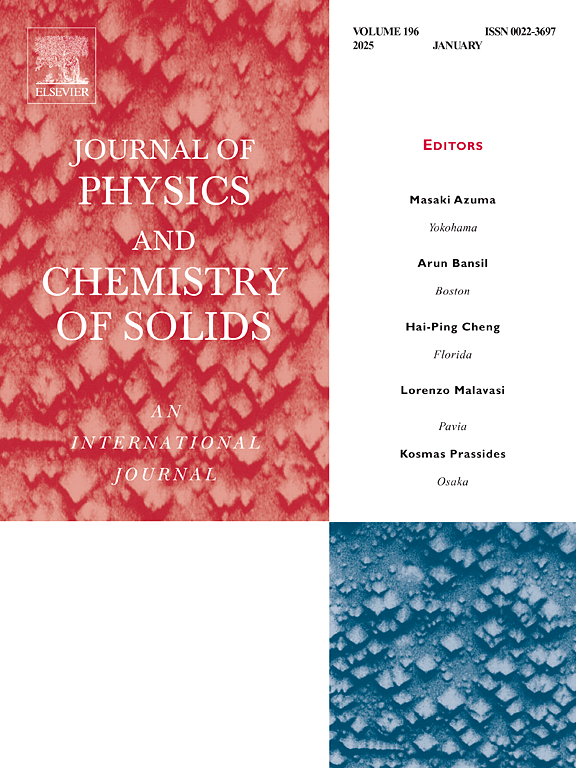通过添加Y和熔体纺丝改善镁镍基合金的储氢性能
IF 4.9
3区 材料科学
Q2 CHEMISTRY, MULTIDISCIPLINARY
引用次数: 0
摘要
氢吸收/解吸动力学慢和热稳定性高被认为是制约镁基储氢合金实际应用的主要障碍。为了克服这些缺点,采用熔体纺丝技术合成了具有纳米晶和非晶结构的Mg25-xYxNi10 (x = 0,1,3,5,7)合金,以提高其吸氢/解吸性能。采用Arrhenius法和Kissinger法对合金的脱氢活化能进行了估算。熔融纺丝法制备的Y部分取代镁合金的启动脱氢温度和热力学参数(ΔH, ΔS)均显著降低。Y对Mg的部分取代是Mg - Y - ni合金储氢容量下降的主要原因,随着纺丝速率的升高,吸氢容量先增大后减小。Y部分取代Mg和熔融纺丝使合金的脱氢动力学得到显著改善,而吸氢动力学略有下降。随着Y含量和纺丝速率的增加,合金的脱氢活化能显著降低,当纺丝速率从0 m/s增加到30 m/s时,Y5合金的ekde值从68.61 kJ/mol降低到53.84 kJ/mol,当Y含量从0增加到7时,合金的ekde值从65.96 kJ/mol降低到48.86 kJ/mol。脱氢活化能的降低也被认为是合金脱氢动力学增强的主要原因。本文章由计算机程序翻译,如有差异,请以英文原文为准。
Improving hydrogen storage characteristics of Mg–Ni-based alloys by adding Y and melt spinning
Slow hydrogen absorption/desorption kinetics and high thermal stability are regarded as major setbacks for the real application of Mg-based hydrogen storage alloys. Overcoming these shortcomings, the Mg25-xYxNi10 (x = 0, 1, 3, 5, 7) alloys with nanocrystalline and amorphous structures were synthesized by melt spinning technology to improve their hydrogen absorption/desorption properties. The dehydrogenation activation energy of the alloy was estimated using the Arrhenius and Kissinger methods. The starting dehydrogenation temperature and thermodynamic parameters (ΔH, ΔS) of Y partially substituted Mg alloys prepared by melt spinning technique were significantly decreased. The partial substitution of Y for Mg is the main reason for the decrease in the hydrogen storage capacity of Mg–Y–Ni alloys, and the hydrogen absorption capacity increases in the beginning and then declines with the spinning rate rising. Partial substitution of Mg by Y and melt spinning resulted in a significant improvement in the dehydrogenation kinetics of the alloy along with a slight decrease in the hydrogen absorption kinetics. The dehydrogenation activation energy of the alloys decreased significantly with increasing Y content and spinning rate, when the spinning rate was increased from 0 m/s to 30 m/s, the -value of Y5 alloy decreased from 68.61 kJ/mol to 53.84 kJ/mol, and when the Y content was increased from 0 to 7, the -value of the alloy decreased from 65.96 kJ/mol to 48.86 kJ/mol. The decrease in dehydrogenation activation energy was also considered to be the main reason for the enhanced dehydrogenation kinetics of the alloys.
求助全文
通过发布文献求助,成功后即可免费获取论文全文。
去求助
来源期刊
CiteScore
7.80
自引率
2.50%
发文量
605
审稿时长
40 days
期刊介绍:
The Journal of Physics and Chemistry of Solids is a well-established international medium for publication of archival research in condensed matter and materials sciences. Areas of interest broadly include experimental and theoretical research on electronic, magnetic, spectroscopic and structural properties as well as the statistical mechanics and thermodynamics of materials. The focus is on gaining physical and chemical insight into the properties and potential applications of condensed matter systems.
Within the broad scope of the journal, beyond regular contributions, the editors have identified submissions in the following areas of physics and chemistry of solids to be of special current interest to the journal:
Low-dimensional systems
Exotic states of quantum electron matter including topological phases
Energy conversion and storage
Interfaces, nanoparticles and catalysts.

 求助内容:
求助内容: 应助结果提醒方式:
应助结果提醒方式:


